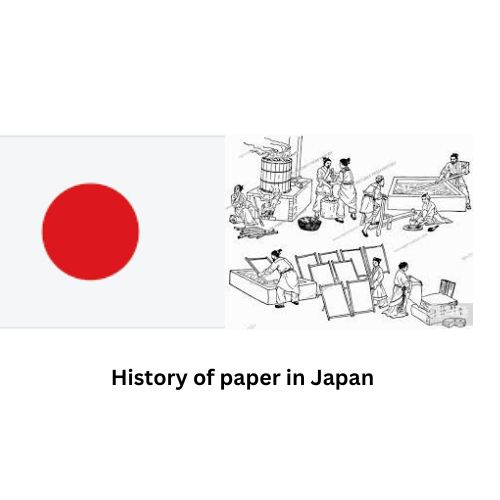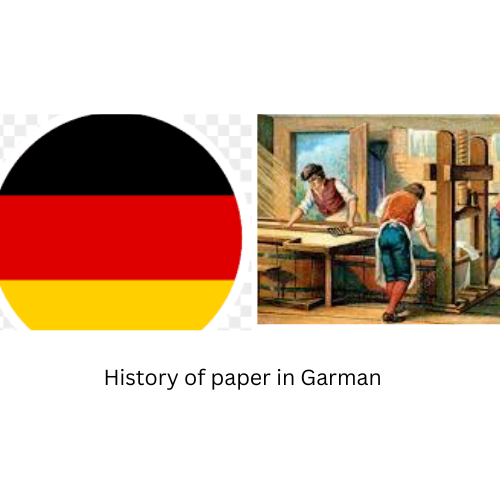In German, paper is called papier. The word paper or papier, comes from that papyrus. The papyrus plant grows abundantly in the swamps along the banks of the Nile River in Egypt, both in ancient times and today. Papyrus is as thick as a human wrist. Papyrus is not only used to make paper but also to make different kinds of pots. But papyrus is called so much for its use as paper.

Before the widespread use of paper, various materials were used for writing and record-keeping in different cultures and historical periods. Here are some key materials:
- Stone: Early humans engraved writings and drawings on stone surfaces, such as cave walls and monuments. Examples include petroglyphs and hieroglyphs.
- Clay Tablets: In ancient Mesopotamia, clay tablets were used for writing cuneiform script. The tablets were inscribed with a stylus and then baked to preserve the writing.
- Papyrus: The ancient Egyptians developed papyrus, a writing material made from the pith of the papyrus plant. It was used for creating scrolls and documents.
- Parchment: Made from animal skins (usually sheep, goat, or calf), parchment was used in ancient Greece, Rome, and throughout the Middle Ages for important documents, books, and manuscripts.
- Bamboo and Wood: In ancient China, bamboo strips and wooden tablets were used for writing. These materials were bound together to form books.
- Wax Tablets: Used in ancient Greece and Rome, wax tablets consisted of wooden frames filled with wax. A stylus was used to inscribe text, and the wax could be smoothed over for reuse.
- Bone and Shell: In early Chinese writing, inscriptions were made on bones and turtle shells, particularly for divination purposes during the Shang dynasty.
- Metal: Some ancient cultures used metal sheets, such as bronze or lead, for inscribing important texts, treaties, and inscriptions.
- Tree bark: Various indigenous cultures used tree bark as a writing surface. The Mayans, for example, created codices from the inner bark of certain trees.
- Leather: Before parchment became widespread, leather was sometimes used as a writing material, especially for scrolls.
These materials varied in durability, ease of use, and accessibility, influencing the development of writing systems and record-keeping practices across different civilizations.
- History of paper in China: It is believed that paper was produced in China long before the birth of Jesus. However, it was in 105 AD that the Chinese emperor was first officially informed that a man named Sailang had discovered the process of making paper. Chinese Sailang is known in Chinese history as the father of the invention of paper. But they kept their discovery a secret for a long time. No other country knew anything about it until 110 BC.

- History of paper in Japan: As papermaking was kept a secret by the Chinese until 110 AD, it was revealed to the Japanese via the Chinese province of Korea. This is how the Japanese learned the art of papermaking and started using paper. Note here that paper was made from old rags in China and Japan.

- History of paper in Turks: A war broke out between the Chinese and the Turks in 751 AD. The Chinese were defeated in the battle and a large number of soldiers and civilians were captured by the Turks. Many of these prisoners were papermakers. With the help of these prisoners, the first paper mill was established in 569 AD. The Turks enjoyed the exclusive commercial and practical advantages of the papermaking system until the middle of the 12th century.

- History of paper in Iraq: Paper mills were established in Baghdad, the capital of Iraq in 790 AD, shortly after the Turks. At that time, paper and thread were made of woven cloth. This paper was beautiful and long-lasting. However, knowledge of the art of papermaking changed with the growth and expansion of Muslim power and civilization.

- History of paper in Spain: Due to the development of Muslim civilization and power in Spain, the art of papermaking made its way across the Mediterranean to European countries, Spain. The first paper mill was installed there in 150 AD in Toledo.

- History of paper in Italy: After Spain, the paper mill was established in Italy in 1276 AD. In Italy, however, papermakers are more concerned with the craft of paper preparation. For example, Italian paper was the first to introduce watermarks, but the watermarks were originally used to identify paper manufacturers.

- History of paper in Garman: The next country of paper origin is Germany. A German merchant named Willmann Stomer established the first paper mill in Nuremberg, Germany in 1390 AD. Here, also very good-quality paper was made.

- History of paper in England: 105 years after paper was made in Germany, a paper mill was established in England in 1895 by Threatt, son of the Lord Mayor of London. However, the production of the paper mill was not a commercial success. Since then, England has not had a paper mill for nearly 100 years. Then in 1589, a man named John Plinman set up a paper mill and became a successful merchant and received a royal charter.

- History of paper in United Sate: American paper mills were established in the 1690s, but they had no commercial success in producing and supplying paper before 1760. By the 20th century, the United States emerged as a global leader in paper production, thanks to further technological innovations and industrialization.

- History of paper in India: After many centuries, the material of paper was reborn in the hands of the Muslim rulers of India. It is generally believed that a Muslim ruler of Kashmir introduced the first paper in India between 1420 AD and 1470 AD. After that, the first paper mill was established in Nowsherai located in present-day Pakistan. This business then started producing paper in Sialkot, Lahore, Delhi, Mathura, Multan and much later in Bangladesh and Hyderabad.

So finally, it can be said that in the expansion of human society, the rapid expansion of the medium of expression, the greater accessibility, the possibility of attaining spiritual value, paper has been considered the best.



